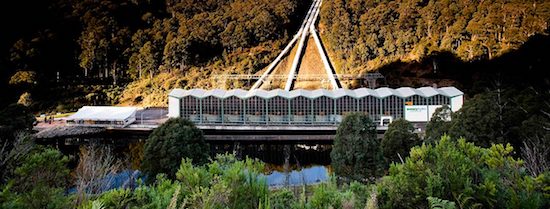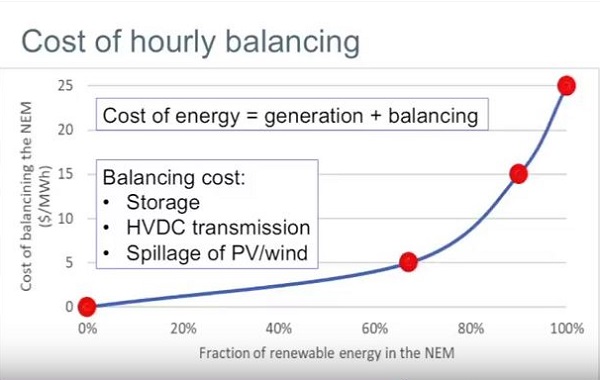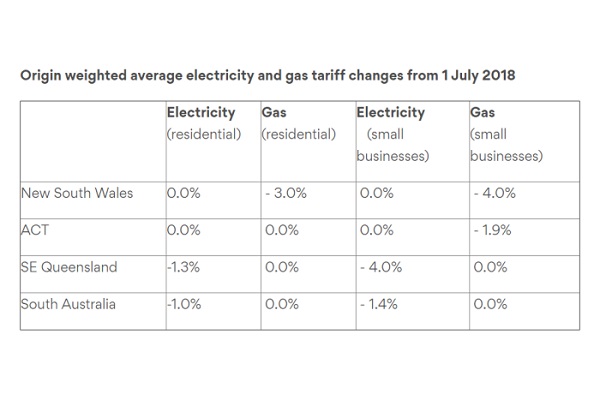
Snowy Hydro 2.0 was, I thought, being justified at the political level by its capacity to back up with pumped storage some of the “reckless” development of wind and solar energy around the place. RenewEconomy now reports that Snowy Hydro is itself planning to develop 800 MW of wind and solar capacity. It has put out an expression of interest document, aiming to conclude contracts by September:
- “The initial aim is to procure 400MW of wind and 400MW of solar off takes,” the document states, although the company may change its mind on the 50/50 split between wind and solar depending on the offers made.
“Snowy Hydro’s goal is to construct a portfolio of wind and solar offtakes such that the resulting portfolio benefits from diversification of fuel sources (wind / sun), geography (across NEM States, latitude and longitude) and supply profile (intra-day, week, month and season).”
I would have thought it more economic and appropriate to back up geographically dispersed wind and solar facilities with pumped storage nearby. However, rooftop solar is starting to become a significant resource and is happening everywhere. In March NSW had 1.47 GW of rooftop solar capacity, which in May grew by 39 MW.
Rooftop solar is becoming disruptive, producing dips in network demand during daytime peaks.
- one third of homes in Queensland and South Australia had rooftop solar, 25 per cent in Western Australia and 17 per cent in NSW (and growing fast).
This compared to just 20 per cent in Hawaii and California, often seen as the global leaders in the uptake of rooftop solar.
So thought is being given as to how it should be managed and integrated with network electricity. In the next few days Energy Networks Australia and the Australian Energy Market Operator plan to release a joint study about the appropriate platform to manage the growth in distributed energy.
- Companies like Greensync, Reposit, Tesla, and sonnen have ideas of how that can be done – through the creation of virtual power plants and other “aggregated source” that links and connects these resources.
The NSW government seems intent on running trials about managing distributed energy. Will they think of the potential of Snowy 2.0? Professor Andrew Blakers said the Snowy 2.0 would be able to supply 2 GW of electricity for two weeks, or around 350 GW hours. However, there is no evidence I have yet seen that the Commonwealth or Snowy Hydro are considering the possible role of backing rooftop solar. Snowy management seem keen to strike agreements with large-scale wind and solar generators. The costing from their documents runs like this:
- “On that firming product we have wind at about $40, and us with a firming product of around $40 as well—around $80. Those costs are coming down rapidly.”.
These estimates are backed up by new documents released by Snowy Hydro that suggests wind (including a price premium for firming) is approx $70 – $80/MWh, and solar with a price premium for firming is about $77 – $99 per MWh.
This compares to the price of new coal plants of $78 – $120/MWh depending on capacity factor, and the cost of gas, assuming sufficient quantities can be sourced on existing infrastructure, of $100-$125/MWh.
Andrew Blakers Youtube (see about 23:50) puts the cost of firming renewables with dispersed pumped hydro as follows:

Blakers’ estimated costs come in at less than $5 MWh until the system reaches over 60 per cent renewables, and tops out at about $25 with 100 per cent.
Snowy Hydro has significant financial grunt, as it is becoming a major force in the electricity generation market:
- it owns and operates the 4,100MW Snowy Mountains Scheme, the 300MW Valley Power gas-fired power station, the 320MW Laverton North gas-fired power station and the 667MW gas-fired generator at Colongra in NSW.
It also owns and operates diesel fired peakers in South Australia, and since the purchase of Lumo Energy (to add to Red Energy), it has become the fourth biggest energy retailer in the National Electricity Market.
The article says “retailer”, I think they mean “generator”.
Meanwhile Origin has announced electricity price reductions in Queensland and South Australia, and a freeze in NSW and the ACT. Victorian prices change from the beginning of the year, rather than 1 July. Frydenberg says wholesale prices have come down by 30 per cent. Remembering that the actual electricity only forms 25 per cent of the bill or a little under, a price reduction of 1.3 per cent in SEQ seems mean, considering there was a 15 per cent increase last year. Here’s a table of the price changes:

Frydenberg, talking to Patricia Karvelas, got away with saying prices were reducing because prices were reducing and then went on to mention a range of factors including Snowy 2.0, virtually claiming the credit for the government. Renewable energy did not get a mention.
Origin Energy talking to Steve Austin, said prices were reducing because of renewables. Other factors were mentioned. The SEQ network distributor Energex has reduced its charges, and the government instruction to the state-owned generators to lower their bids had an effect. However, the Origin representative thought we might be at a turning point where future investments in renewables would continue place downward pressure on costs and prices.
Origin itself has invested in the Clare and Daydream solar farms, and expected to make further such investments.
Frydenberg and Malcolm Turnbull sing from a different song sheet, consistently blaming a reckless plunge renewables for all the electricity sectors woes, citing Snowy 2.0 as a responsible remedial action. Unfortunately Frydenberg’s regular use of spin means that you can’t take at face value anything he says.
To bring all this together, the Commonwealth now owns a large and significant electricity generator, and by buying out NSW and Victoria, seem committed to a massive pumped hydro scheme which is shaping as hopelessly uncompetitive and seems destined to crowd out cheaper and more appropriate investment in pumped hydro and other levelling technologies.
Snowy Hydro’s brief no doubt is to maximise the dollar return to their shareholder, the Commonwealth of Australia. In Frydenberg we have a minister who undoubtedly has a brain, but seems not to be applying it to resolve the best use of a large asset in the public interest.

Brian,
FYI, broadcast last night on ABC 7:30, there was a segment on New details on potential pumped hydro in Tasmania, link here.
Brian, you say:
Blakers says it’s a trade-off between pumped-hydro storage and interconnectors (YouTube 2017 CURF Annual Forum – Andrew Blakers keynote from 8:20 and 23:35). In the longer term, Australia could become the energy superpower for Asia through HVDC interconnector sea cables.
Indeed it is, but I wonder whether the current grid configuration allows rooftop solar-PV to feed back through the local transformers to a potential nearby pumped-hydro facility, or only supplies to the neighboring houses along the street that don’t have rooftop solar.
Note that Blakers’ Cost of hourly balancing is the “upper bound figures” (from 25:12) – optimization could make balancing costs significantly lower.
Meanwhile in the AFR is the online article headlined Thermal coal price surge expected to deliver record royalties to NSW, dated June 6, link here.
One of the potential advantages of solar is that it can be turned on or off very quickly (and in small modules) in order to provide fast reactions to changes to demand or power generated.
Even better if batteries/other storage is used to reduce power wastage during demand reduction.
It is also worth noting that houses don’t need 7.5 kWh batteries to handle short variations in solar output. The larger batteries will reduce the amount of imported power required and are essential if a house wants to go off grid.
Brian: Further to the above REnewEconomy came up with a detailed rebuttal of claims rooftop solar would cause blackouts.
Worth a read. To summarise:
Queensland Energy Minister Dr Anthony Lynham said the Government had introduced several measures to future-proof the network.
Geoff M, I missed the 7.30 Report because I switched to the State of Origin rugby league fest. I did see this article at RenewEconomy, but actually forgot to look at it before posting. There is also another on the interconnectors needed, and one at the AFR.
Seems the build cost per MW would be about half Snowy. Also the grid connection would be about $1 billion for Tasmania as against $2 billion for Snowy.
They are looking at 2500 MW but don’t say how long that would run for. They seem to be looking at wind and gas to lift the water, but who is going to build them is not clear. Probably Tasmanian Hydro.
They could probably do it off their balance sheet. Snowy is apparently going to self-fund Snowy 2.0 without tax payer input.
John D, thanks for that. There was an article Urgent call for reforms as solar powers up and NSW flags co-ordinated transmission to unlock $18b of investment.
It does seem that Snowy 2.0 may be too far away to use the power off Sydney rooftops, but Qld’s resources minister Anthony Lynham says here we are going to do just that in SEQ withg the Wivenhoe Dam. The difference would be, I think, that Wivenhoe dam is within the Energex distribution area, being 70.9 km by road from the CBD, probably 50 km via the power line.
The Parkinson article takes on the regulators and firms with profit prospects and accuses them of conducting a scare campaign. He certainly seems to have mastered the detail, but he says:
My question is how we are going to move to a new grid, with a huge and in most states privatised stake in the old one?
We have a layered system (generation, high voltage transmission, distribution, retail, consumer and distributed generator) split into privatised bits. Queensland probably has enough state ownership to make rational decisions across the whole system, but it would be quite difficult in the other mainland NEM states.
In this context AEMO, the Energy Security Board and COAG are doing the forward planning. We should remember that Frydenberg has one voice on COAG and they operate on consensus.
John Davidson (Re: JUNE 7, 2018 AT 10:06 PM):
Here’s a link to Key Updates to the Standard and what they mean for Installers.
Brian (Re: JUNE 7, 2018 AT 11:24 PM):
It requires effective policy formulation and en-action from governments. It’s too big for the markets to do it.
Dated June 5, the AEMO has posted On the road with AEMO! Link here. It includes a 4 minute video – 17 AEMO employees from across AEMO’s offices gathered in New South Wales to kick start their bus tour of Taralga Windfarm and Snowy Hydro on May 2.
Yesterday, SMH online article headlined Energy bosses say power companies need to work together, or else, link here. It included:
I think it is inevitable that governments need to step in. Markets don’t necessarily act in the people’s (, states/territories’ or nation’s) best interests. Therefore, governments need to formulate effective policy and regulate, and if necessary, step in if markets won’t act effectively and in a timely manner.
YouTube video titled 2017 CURF Annual Forum – Andrew Blakers keynote is up to 176 views.
In yesterday’s The Australian, there’s an article by political reporter Joe Kelly headlined Monash Forum MPs release coal ‘fact sheets’. The article includes a link to the Monash Forum’s “FACTSHEET1”, link here. The table of numbers is headlined by “NEW COAL-FIRED POWER STATIONS”.
Note that the source for the “FACTSHEET1” is shown as: CoalSwarm, Global Power Plant Tracker, Coal Plants by Country, January 2018.
The information is sourced from endcoal.org, link here, and the numbers appear to match the numbers in the Coal Plants By Country (Units) – January 2018 spreadsheet (3rd link down the Summary Statistics list). This table is for the number of generator units (not power stations). Power stations may have multiple generator units on the same site. It seems the Monash Forum is confusing the terminology of generator units with power station sites – I wonder whether that is deliberate?
It’s interesting that the Monash Forum appears to be endorsing information from a website with the URL endcoal.org – how ironic.
The Monash Forum is not mentioning that in the March 2018 publication Boom and Bust 2018: Tracking the Global Coal Plant Pipeline, click on the Reports link, on page 3 in the Executive Summary, that includes:
Perhaps that is information that the Monash Forum doesn’t want highlighted – far too inconvenient for their narrative perhaps?
That would be a bad error, if it’s what they did.
Hazelwood for example, 1600 MW capacity with 8 units.
That was one power station. 200 MW each unit.
Counting power stations seems a bit crude. Isn’t there a better way? Nameplate capacity??
Ambigulous (Re: JUNE 22, 2018 AT 10:41 PM):
There is, and https://endcoal.org/global-coal-plant-tracker/ shows this in the link for Coal Plants by Country (MW) – January 2018.
The Australian article by Joe Kelly headlined Monash Forum MPs release coal ‘fact sheets’, refers to the Monash Forum’s first of their “fact sheets” outlining the number of new coal-fired power stations across the globe, and provides a link to it.
The article then states:
So it appears political reporter Joe Kelly picked up on the error. Likewise, David Crowe in the SMH article headlined Coalition MPs reject Tony Abbott warning on energy and climate change, says:
Ooops. The Monash Forum needs to be a bit more precise.
What they probably don’t want to highlight is the March 2018 publication Boom and Bust 2018: Tracking the Global Coal Plant Pipeline, on page 8, Figure 5: Coal Power Capacity in Pre-Construction and Construction, January 2016 to January 2018 (Gigawatts), which shows declining capacity between 2016 and 2018. In other words, some new coal-fired power station projects are being cancelled/abandoned. That tends to spoil the narrative, according to Monash Forum member Craig Kelly on-air at Radio 2GB in the early hours of June 22, when he said:
Meanwhile Indian Energy Minister flags a massive 100GW solar tender.
In Friday’s SMH was an article by Cole Latimer headlined Snowy 2.0 needs to double or triple in size, hydro chief says, link here.